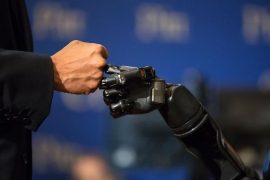The web has given everybody a voice, which definitely has positive ramifications for the manner in which citizens can publicly challenge authority and discussion issues. Then again, when challenge and discussion overflow into attacks on minorities or sensitive individuals, there’s definitely a potential for hurt.
It’s kind of usually accepted that this type of hate speech, especially when experienced close by different factors, for example, social hardship or psychological sickness, can possibly radicalize people in perilous ways, and rouse them to submit illicit and brutal acts.
Similarly, as terrorist based associations like ISIS can be seen using hate speech in recordings and publicity material expected to prompt violence, racist and anti-Islamic material is thought to have propelled killers like Anders Breivik, who killed 69 adolescents in a 2011 shooting binge, and the 2019 Christchurch mosque shooting in which 51 kicked.
So far these connections among the web and real-world activities, however presence of mind tell us they are probably going to exist, have been hard to demonstrate logically. In any case, a bit of the puzzle became allgood gratitude to investigate did by the UN and the Universitat Pompeu Fabra and co-ordinated by IBM.
IBM guideline analyst Kush Varshney tells me “I think the important message was this was the main study of its sort looking at the connection among on the online and offline practices, and above all, it demonstrates why we ought to be adopting this specialized strategy to contemplating that relationship.”
Researchers started by ordering a list of keywords and phrases considered by governmental offices and NGOs to be indicators of hate speech. These included expressions found in both Islamic- extremist and anti-Islamic posts made on Twitter and Reddit. As the researchers approved that these words and expressions were, in reality, regular via looking over those stages, they went over other co-occurring terms that were likewise added to the list. Alongside news reports of Islamic terrorism or against Islamic violence, this list was the essential wellsprings of data for the investigation.
This client created content – more than 50 million tweets and 300,000 Reddit posts, made by around 15 million clients – containing these words and expressions were then grouped by factors including their position (Islamic-extremist or anti-Islamic), just as the seriousness of the message. The size of seriousness extended from basic use of discriminatory language to by and large incitement to brutality, including genocide.
The study additionally thought about the framing of the remarks –whether the purpose of the post was to characterize an issue (“Muslims are likely to be terrorists”), analyze a cause (“Immigration leads to increased terrorism “), make an ethical judgment (“Christianity is an evil religion”) or proposes an answer, for example, carrying out terrorist attacks to accomplish political points.
After the dataset was aggregated and grouped, a course of events examination was completed, using machine learning to draw an image of the connection between the quantity of hate speech messages appearing on the online, and various of real-world incidents including the 2016 Orlando nightclub shooting, the 2016 Istanbul airport attack, the 2016 Finsbury Park, London, vehicular attack and the 2016 Olethe, Kansas shooting. The entirety of the episodes included Muslims or Arabs as either victims or perpetrators and occurred inside 19 months.
Beforehand, most of the machine learning analysis around the idea of hate speech has focussed on building calculations to decide if specific posts or pieces of content are hateful.
Varshney tells me “many individuals in the machine learning community are handling the issue of arranging whether speech is offensive or hateful – we concluded it wasn’t significant for us to handle that issue, and frequently it’s an issue of where you draw the line if something is almost being hateful.
“What we were looking at is what’s the connection between things that happen in the online world, and things that occur in reality.”
The study found that, truly, following high-profile incidents of both Islamophobic or Islamic- extremist violence, occurrences of online hate-speech do in reality increment. This didn’t generally come as an amazement to anybody as it was ordinarily held to be genuine dependent on easygoing observation. In any case, what was fact all the more fascinating was the way that, on account of Islamist-extremist brutality it wasn’t simply Muslims who confronted an expansion in hate speech against them, yet attacks were much of the time widened to other minority gatherings.
Varshney told me “The seriousness of the attacks likewise increases, so individuals are significantly more liable to prompt brutality … and the objective of the online messages additionally widens so different gatherings that have nothing to do with whatever’s occurred in reality likewise experience an expansion in hate speech. It could be some other gathering, for example, homosexuals … those were some fascinating findings.”
All in all, is online hate speech and real-world violence a circular problem? It’s been indicated that one (realworld violence) causes the other – however, is simply the opposite additionally a vicious, self-feeding circle of hatred and violence?
As of now, that remaining unclear. Be that as it may, demonstrating the causal connection between hate speech and violence is a characteristic for research in the world following stage for research in the field, Varshney says. Demonstrating this opposite relationship is probably going to be increasingly risky, notwithstanding, for various reasons. Including the way that the procedure of online radicalization itself isn’t yet surely known from a logical viewpoint. The subject of how many introductions to derisive material is expected to push an individual to submit viciousness, over what time, and how the mental health -being of the individual has its influence, still can’t seem to be replied.
Varshey told me “That would probably be a much progressively significant investigation to do – we didn’t get into it in this specific project, as a portion of the causal connections require methods that we don’t yet have. “That motivates us to accomplish increasingly specialized work, however – and this heading is plainly the following stage for the work, that ought to be done, without a doubt.”
The research, which can be seen in full here, was completed as a major aspect of IBM’s Science for Social Good, which expected to apply machine learning to 17 issues distinguished by the UN as Sustainable Development Goals.





